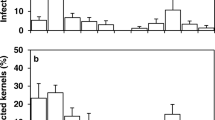Abstract
Peanut stem and pod temperatures of plants growing in irrigated, drought, drought-heated soil, and drought-cooled soil treatments were determined near the end of the growing season. Mean soil temperatures of the treatments during this period were 21.5°, 25.5°, 30° and 20 °C, respectively. Peanut stem temperatures in all drought treatments reached a maximum of ca. 40 °C and for 6–7 h each day were as much as 10 °C warmer than irrigated peanut stems. Pod temperatures in drought-heated soil and drought treatments were ca. 34 °C and 30 °C, respectively, for several hours each day. As pod temperatures approached the optimum for A. flavus growth (ca. 35 °C), the proportion of kernels colonized and aflatoxin concentrations increased. Increased plant temperature without accompanying pod temperature increases (drought-cooled soil) resulted in colonization percentages and aflatoxin concentrations only slightly higher than those of the irrigated peanuts.
Similar content being viewed by others
References
Blankenship, P. D., R. J. Cole & T. H. Sanders, 1980. Rainfall control plot facility at National Peanut Research Laboratory. Proc. Am. Peanut Res. Ed. Assoc. 12: 46.
Blankenship, P. D., R. J. Cole, T. H. Sanders & R. A. Hill. Effect of geocarposphere temperature on preharvest colonization of drought stressed peanuts by Aspergillus flavus and subsequent aflatoxin contamination. Mycopathologia (in press).
Cole, R. J., R. A. Hill, P. D. Blankenship, T. H. Sanders & K. H. Garren, 1981. Influence of irrigation and drought stress on Aspergillus flavus invasion of corn kernels and peanut pods. Dev. Ind. Microbiol. 23: 229–236.
Dickens, J. W., J. B. Satterwhite & R. E. Sneed, 1973. Aflatoxin contaminated peanuts produced on North Carolina farms in 1968. J. Am. Peanut Res. Ed. Assoc. 5: 48–58.
Diener, U. L. & N. D. Davis, 1977. Aflatoxin formation in peanuts by Aspergillus flavus. Agricultural Experiment Station bulletin no. 493, Alabama Agricultural Experiment Station, Auburn, Ala.
Griffin, G. J. & K. H. Garren, 1976. Colonization of aerial peanut pegs by Aspergillus flavus and A. niger-group fungi under field conditions. Phytopathology 66: 1161–1162.
Hill, R. A., P. D. Blankenship, R. J. Cole & T. H. Sanders, 1983. The effects of soil moisture and temperature on preharvest invasion of peanuts by the Aspergillus flavus group and subsequent aflatoxin development. Appl. Environ. Microbiol. 45: 628–633.
Sanders, T. H., R. A. Hill, R. J. Cole & P. D. Blankenship, 1981. Effect of drought on occurrence of Aspergillus flavus in maturing peanuts. J. Am. Oil Chem. Soc. 58: 966A–970A.
Wells, T. R. & W. A. Kreutzer, 1972. Aerial invasion of peanut flower tissues by Aspergillus flavus under gnotobiotic conditions. Phytopathology 62: 797.
Author information
Authors and Affiliations
Rights and permissions
About this article
Cite this article
Sanders, T.H., Blankenship, P.D., Cole, R.J. et al. Effect of soil temperature and drought on peanut pod and stem temperatures relative to Aspergillus flavus invasion and aflatoxin contamination. Mycopathologia 86, 51–54 (1984). https://doi.org/10.1007/BF00437229
Issue Date:
DOI: https://doi.org/10.1007/BF00437229




